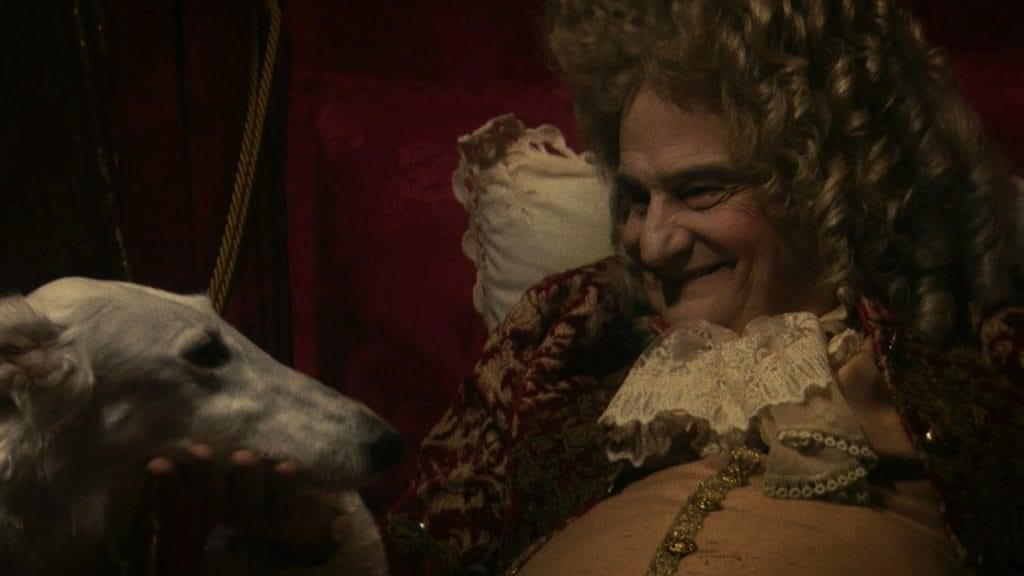
Like prison tattoos, coffee stains, and dirt under fingernails, “Blue Murder” clings to you.
Jump in the shower with steel wool and scrub with all your might. It won’t wash away the shattered glass, bullet wounds, and twisted loyalties that tarnish Michael Jenkins’ notorious 1995 crime epic, originally televised as a miniseries. A gritty, Australian hot potato based on actual events and banned from New South Wales for half a decade, “Blue Murder” follows the amoral alliance forged between legendary cop Roger “The Dodger” Rogerson (Richard Roxburgh of “Moulin Rouge”) and lowlife crook Arthur “Neddy” Smith (Tony Martin).
“Blue Murder” begins with the squeal of brakes and the crackle of gunfire, during a failed robbery attempt. Booked for the crime, Neddy Smith is your average antisocial, career-criminal scumbag. Built like a brick, Neddy sports a sparse head-bed of carrot-colored hair, prominent forehead, and beady eyes. He looks like a skuzzy, scary potato bag of damaged goods. But this living, breathing mug shot is also a human being with identifiable human problems – like the onset of Parkinson’s disease.
“Blue Murder” wastes no time getting us under Neddy’s soiled skin. Just as quickly, the film acquaints us with its other key personality – celebrated cop Roger “the Dodger” Rogerson. Blonde and blue-eyed, Rogerson is charismatic, outgoing, and charming. (His Aussie smile suggests sunny Paul Hogan of “Crocodile Dundee.”) But his nickname was given for a reason. Boy, does this slippery bastard ever dodge. Dodges bullets. Dodges fists. Dodges accountability. Beneath his leathery-yet-handsome veneer, the Dodger is Australia’s most crooked cop. He bribes fellow officers, deals a little heroin on the side, and gives select criminal informants the “Green Light” – meaning, complete immunity from the law. As “Blue Murder” unfolds, we watch Rogerson grant this insider status to Neddy.
We follow Neddy and Rogerson through an unholy alliance of corrupt dirty deeds, which spans decades. But director Jenkins also throws in a moral conscience. Undercover cop Michael Drury is a decent man, principled law enforcer, and loving husband and father. But when he goes after the wrong heroin dealer – one of Rogerson’s criminal cronies – a tidal wave of nastiness washes over the police department that makes Frank Serpico’s woes seem trivial by comparison. Rogerson offers Drury a bribe to tamper with evidence and allow the dealer to walk. When this honest “blue” refuses, The Dodger takes it personally.
In a horrifying, emotionally wrenching sequence, Rogerson arranges for Drury to be gunned down. While tending to his children at home, this undeserving human target takes two slugs. Through sheer bullet-biting will power, he survives. Then, things really get interesting. The aftermath of Drury’s shooting provides enough additional plot threads and supporting characters to fill the chambers of a dozen snub-nosed .38’s.
Like so many of the key players in “Blue Murder,” we ultimately lose our way in the film’s thick, pea-soup fog of rule-bending and legal bureaucracy. Which is precisely the point. With no Rambo, Dirty Harry, or John Wayne to set things straight, we sense the very real ambiguity and chessboard politics that taint justice.
The film’s complicated structure is bound to frustrate some. But its fascinating, detailed characters will keep those same viewers from tuning out. “Blue Murder” was written by Ian David, who somehow manages to give all of his cops and robbers unique, individual personalities. Several different actors provide voice-over narrations, and each sentence of punchy wordplay enlightens us to its speakers’ nature. Neddy’s nonchalant resignation to a criminal lifestyle is suggested when he emerges from a two-year prison stint, only to declare, “A man’s gotta earn a living. So I returned to what I do best.”
But “Blue Murder” clearly belongs to Roxburgh, seething arrogance as a man who has been so crooked for so long, he doesn’t have the insight to even acknowledge his wrongdoings. It’s one thing to consciously break the law, knowing that you’re taking a chance. It’s much scarier when someone has no sense of crossing this line – especially when the lawbreaker is a police officer. Perhaps Rogerson was once a good cop. But after years of being on the take and running narcotics through the very creeps he has pledged to take down, The Dodger has traded allegiances.
Yet, Jenkins doesn’t take the easy way out by making this blue-uniformed schemer an obvious villain. The Dodger is dashing and debonair. We catch glimpses of a more reformed family man at home, donning reading glasses to help his high school-aged daughters with homework. He also proves a suave, elegant pianist at cocktail parties. Rogerson says, “To be a good cop, one has to be a man of the world.” He realizes that working on the fringes of society is more effective than by-the-book bureaucracy, and even as we observe him twist and sour, he’s also oddly sympathetic. We can see how someone could lose his moral bearings by dancing with the devil for too long. This intriguing complexity is the stuff that the greatest onscreen baddies are made of, from Hannibal Lecter to Denzel Washington’s antisocial “Training Day” narc.
Ultimately, however, the man is a menace. Even as the Dodger faces an upcoming trial on bribery charges, he’s arranging a dope-smuggling plane to bring in smack from Thailand. And pity the poor, idealistic upstart who tries to cross him. “Take the advice, sunshine,” he instructs a rookie cop hesitant to play by Rogerson’s rules. “I’d hate to see you spend the next five years on four wheels.” Even scarier is Rogerson’s stone-faced, bullying gaze after an honest copy rebuffs his offer of a bribe. Remember the terrifying eyebrow-raise and Satanic grin Robert DeNiro employed in “Goodfellas,” tipping us off to his character’s ruthless greed? Roxburgh’s eyes convey the same eerie power. Saying nothing, the crooked cop stares through this decent officer’s soul and promises brutal retribution.
Not since Sidney Lumet brought the torment of police life to his early-seventies milestones “Serpico” and “Prince of the City” has a director so confidently explored this tense territory. And while critics have compared Michael Jenkins’ approach to popular television crime shows like “The Shield,” it has more in common with Martin Scorsese’s work. There’s a riotous, rollicking bar fight harkening back to the dingy messiness of “Means Streets.” There’s a paranoid drug dealer becoming more unhinged with every intrusive helicopter that tracks him overhead, ala Henry Hill’s coke-fueled pasta prep freakout that concluded “Goodfellas.”
Wondering how to get your paws on “Blue Murder?” Thanks to Subversive Cinema, it’s readily accessible in a special-edition, two-DVD format. Over two hours of supplements, including interviews with cast and crew, add additional grit to this corrosive filmmaking must-see. Subversive has made it their specialty to take cult curios and give them a red carpet, bells-and-whistles resurrection through DVD re-releases, and “Blue Murder” is no exception. A detailed editing workshop with Bill Russo gives outsiders a glimpse at how the project was cut and pasted into a trend-setting powerhouse. Commentary with Jenkins and editor Bill Russo can be reviewed. Other extras include text biographies for the cast and crew, a still gallery, three lobby cards, and a poster.
Cynical naysayers intent on pointing the finger at faults might balk at the film’s Super 16 mm format, which results in a high level of grain. But considering the gritty, in-your-face immediacy of the project, an argument could be made for this raw, unpolished quality. Meanwhile, Yanks could whine about the somewhat difficult-to-decipher Aussie accents and absence of subtitles. Again, this criticism would depend on how willing the viewer is to dive into a different culture and absorb its genuine, challenging rhythms. It takes some work. But the rewards are plentiful.
Speaking of rewards, “Blue Murder” might be an obscure oddity to American audiences, but it has received accolades from the Australian community. In 1996, the miniseries was awarded Logies (the down-under equivalent of the Emmy Awards) for Most Outstanding Actor (Richard Roxburgh) and Most Outstanding Achievement in Drama Production.
Australian filmmaker Mark Savage (“Defenceless,” “Sensitive New Age Killer”), who directed a documentary featurette for the film’s DVD reincarnation (“Blood Brothers”), proclaims “Blue Murder” the best television drama ever made in Australia. “I think the acting is amazing,” he gushes. “Michael Jenkins is an absolutely brilliant filmmaker – the best for true-crime material. I did a film called ‘Stained’ that was very heavily influenced by Michael’s sensibility.
“The style of “Blue Murder” is very cutting-edge in Australia. In many ways, it changed the style of Australian filmmaking. It brought a new level of grittiness, and was very raw. This was something that had never been attempted – especially on television.”
“It was banned in New South Wales because there was a court case pending with the main character Neddy Smith. There was stuff in ‘Blue Murder’ that he’d been charged with. While he sat in jail on other charges, he had court cases coming up over things that were depicted in ‘Blue Murder’ – that he said he didn’t do. New South Wales is where he committed the crimes, and was in jail. It couldn’t be screened there for about five years.”
“I think it’s extraordinarily great,” summarizes Savage, “especially for television.”
Bleach. Dishwashing detergent. Alcohol. Try as you might, there’s no washing “Blue Murder” out of your system.
KJ Doughton resurrects reels and breathes life back into films currently on life support and verging on extinction. Applying his “rave resuscitation” to movies at risk of fading into obscurity due to old age, faltering promotional systems, premature delivery, societal stigma, or a runty box-office take, he advocates a second chance for flatlining films too important to die.

